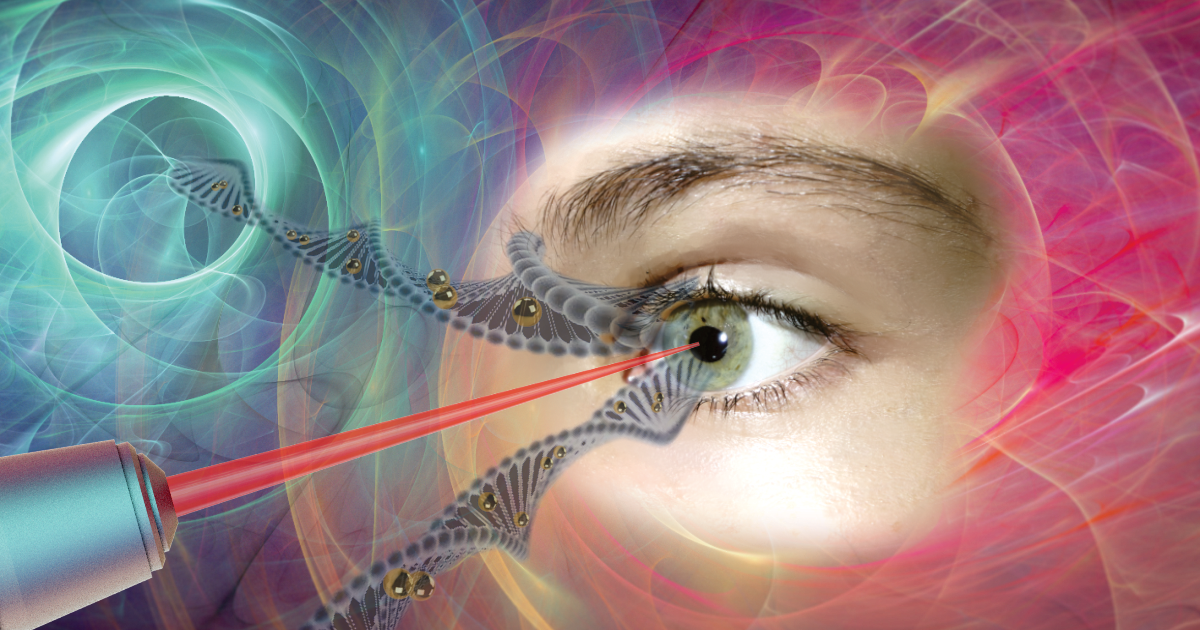Nov 20 2018
The life of Michel Meunier, an engineer and professor at Polytechnique Montréal, changed significantly in January 2009. Similar to others, he had noticed that the exceptionally short pulse of a femtosecond laser—that is 0.000000000000001 second—may cause nanometer-sized holes to appear in silicon when it was enclosed by gold nanoparticles.
 Polytechnique Montréal’s light scalpel. Gold nanoparticles, which act like “nanolenses,” concentrate the energy produced by the extremely short pulse of a femtosecond laser to create a nanoscale incision on the surface of the eye’s retina cells. This technology, which preserves cell integrity, can be used to effectively inject drugs or genes into specific areas of the eye, offering new hope to people with glaucoma, retinitis or macular degeneration. (Image credit: Polytechnique Montréal)
Polytechnique Montréal’s light scalpel. Gold nanoparticles, which act like “nanolenses,” concentrate the energy produced by the extremely short pulse of a femtosecond laser to create a nanoscale incision on the surface of the eye’s retina cells. This technology, which preserves cell integrity, can be used to effectively inject drugs or genes into specific areas of the eye, offering new hope to people with glaucoma, retinitis or macular degeneration. (Image credit: Polytechnique Montréal)
However, Meunier, who was known globally for his skills in nanotechnology and laser, took a decision to move one step further with what was merely a laboratory curiosity at that time. He wondered whether it was feasible to move from silicon to living matter, that is, from inorganic to organic. Will the femtosecond laser (“light scalpel”) and gold nanoparticles be able to recreate the same phenomenon with living cells?
To find an answer to this question, Professor Meunier began working on cells in vitro in his Polytechnique lab. However, the complexity was to make a nanometric incision in the extracellular membrane of the cells without affecting it. With the help of gold nanoparticles that behaved as “nanolenses,” Professor Meunier discovered that the light energy coming from the laser at a wavelength of 800 nm can possibly be concentrated. However, since the cells absorb very little energy at this wavelength, their integrity is maintained, which led to a fruitful conclusion.
On the basis of this finding, Professor Meunier started to work on cells in vivo—cells that form a part of an intricate living cell structure, for instance, the eye.
The eye and the light scalpel
Professor Meunier met Przemyslaw Sapieha, a leading eye specialist specifically known for his work on the retina, in April 2012. Nicknamed as “Mike,” Sapieha is a professor in the Department of Ophthalmology at Université de Montréal and also a researcher at Centre intégré universitaire de santé et de services sociaux (CIUSSS) de l’Est-de-l’Île-de-Montréal. He instantly saw the possibility of this novel technology and everything that can be done in the eye if the ripple effect is blocked that occurs after a trigger, which results in macular or glaucoma degeneration, for instance, by administering proteins, drugs, or even genes.
The eye is a fragile and highly specialized organ; however, using a femtosecond laser to treat this organ is extremely challenging. Since the eye is part of the central nervous system, the majority of the cells or groups of cells present in it are neurons, and when a neuron is destroyed, it will not reproduce like other cells. Hence, the first task of Mike Sapieha was to make sure that a femtosecond laser could be applied on one or a number of neurons without damaging them; this method is known as “proof of concept.”
Proof of concept
Both Michel and Mike sought Ariel Wilson, a biochemistry researcher and an expert in vision mechanisms and eye structures, and also Professor Santiago Costantino and his group from the Department of Ophthalmology at Université de Montréal and the CIUSSS de l’Est-de-l’Île-de-Montréal for their know-how in biophotonics. Since healthy cells are better understood in comparison to sick cells, the researchers first decided to work on the former. They injected gold nanoparticles integrated with antibodies to target certain neuronal cells in the eye, and subsequently waited for the nanoparticles to settle around the different neurons or groups of neurons, for example, the retina.
After the femtosecond laser produced the bright flash, the predicted phenomenon took place—tiny holes appeared in the cells of the retina of the eye, which made it possible to effectively administer genes or drugs in particular eye areas. These conclusive outcomes could now pave the way for novel treatments, marking another victory for Michel Meunier and his research team.
Extreme precision is the main aspect of the innovative technology developed by scientists from Polytechnique and CIUSSS de l’Est-de-l’Île-de-Montréal. Using functionalized gold nanoparticles, the light scalpel enables exactly locating the group of cells where the physician will need to intervene.
Post the successful demonstration of the proof of concept, Professor Meunier and his collaborators filed a patent application in the United States. This remarkable work was also the topic of a paper assessed by a notable reading committee and reported in the renowned journal Nano Letters in October 2018.
Although more research still needs to be done—at least a decade worth, both on animals and humans—the new technology may benefit the aging population afflicted with eye deterioration for which no effective long-term treatments are available yet. The technology also has the benefit of preventing the use of viruses generally used in gene therapy. The researchers are now exploring the use of this technology in all types of eye diseases, but more specifically in macular degeneration, retinitis, and glaucoma.
This light scalpel is indeed unparalleled.